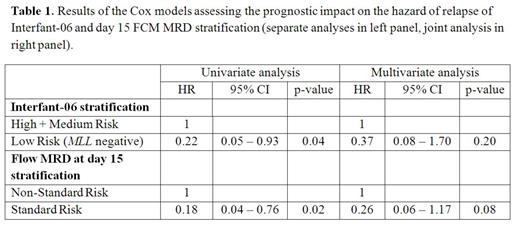Abstract
Acute lymphoblastic leukemia (ALL) in infants is a relatively rare disease with peculiar biological features and worse outcome in comparison to ALL in older children. Infant ALL is characterized by a high frequency of MLL gene rearrangements, mainly CD10-negative B-cell precursor ALL (BCP-ALL) immunophenotype and high tumor burden at diagnosis. Even with new therapeutic approaches event-free survival (EFS) in this subgroup of patients does not exceed 50%. Although flow cytometric (FCM) minimal residual disease (MRD) detection at day 15 of remission induction is well established for patients' stratification in older children treated with the AIEOP-BFM-2009 protocol, the prognostic value of FCM MRD in infant ALL is not fully known yet.
Aim of the present study was to evaluate the prognostic significance of FCM MRD measurement in infants with ALL treated with Interfant-99 and Interfant-06 protocols in AIEOP (Associazione Italiana Ematologia Oncologia Pediatrica) centers in Italy.
Between May 1999 and December 2011, 120 consecutive infants aged 0 to 365 days with newly diagnosed ALL were treated in AIEOP centers with the Interfant99 and the on-going Interfant-06 protocols. Among these patients, 51 (42.5%) with available day 15 follow-up bone marrow samples were included in this study on FCM MRD. In 39 (76.5%) cases, different types of MLL gene rearrangements were identified by fluorescence in situ hybridization (FISH), while 12 (23.5%) patients had germline MLL. MRD detection was performed by 4-6-color FCM. Median follow-up time was 3.5 years (range: 1 month – 7.5 years). Outcome was estimated by evaluating the probability of EFS and the cumulative incidence of relapse (CIR). Analysis of prognostic relevance of FCM MRD in combination with other criteria used for stratifying patients enrolled in the Interfant-06 protocol was performed with the Cox model on the cause-specific hazard of relapse.
We classified infants according to the AIEOP-BFM day 15 stratification into three risk groups: 14 patients (27.5%) were considered at standard risk (SR: MRD less than 0.1%), 9 patients (15.7%) at high risk (HR: MRD 10% or more), and the majority of infants (29, 56.9%) at intermediate risk (IR: MRD 0.1% to 10%). As the 14 SR patients had 3-year EFS and CIR significantly better than other patients, we considered two major groups of patients with different outcome: SR group (MRD<0.1%) with 3-year EFS 77.9% (standard error, SE, 11.3) and CIR 14.9% (SE 10.2), and non-SR group with 3-year EFS 32.0% (SE 8.5) and CIR 58.0% (SE 8.8, p=0.0104 and p=0.0085, respectively). Half of SR group (7 of 14 cases) had germline MLL. 4 out of 7 MLL-positive SR-patients were in continuous complete remission (CCR) In contrast, the majority of infants in the non-SR group carried various types of MLL rearrangements. Only 5 cases in the non-SR group were MLL germline and only two of them are still in CCR. We evaluated the prognostic impact of day 15 MRD in MLL-positive cases (n=39). In this cohort of patients, we also observed a difference, although not statistically significant, between SR and non-SR groups both in 3-year EFS (57.1%, SE 18.7 and 30.9%, SE 9.2, respectively; p=0.3630) and in 3-year CIR (28.6%, SE 18.9 and 60.9%, SE 9.5, respectively; p=0.1733). We evaluated the suitability of MLL negativity and of day 15 FCM MRD <0.1% as single criterion for the identification of low-risk patients. Each factor, when separately analyzed in a Cox model, was significantly correlated with a reduction in the risk of relapse, as shown in Table 1, left panel. Nevertheless, as day 15 FCM MRD levels are strictly related to MLL status, the Cox model which analyzes jointly the two factors, is unable to identify the one independently impacting on the risk of relapse (Table 1, right panel). Thus, although being a strong prognostic factor by itself, day 15 FCM MRD stratification did not confer an advantage in relapse prediction when considered in combination with MLL status, which is the only low-risk group criterion in the Interfant-06 stratification.
Day 15 FCM MRD proved to be a suitable variable predicting treatment failure and can be used as an alternative or in combination with Interfant-06 stratification criteria to identify SR patients.
Popov:Alexion: Research Funding.
Author notes
Asterisk with author names denotes non-ASH members.


